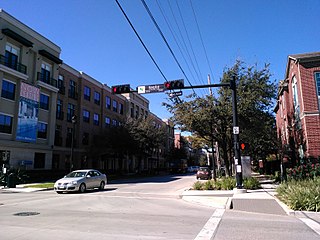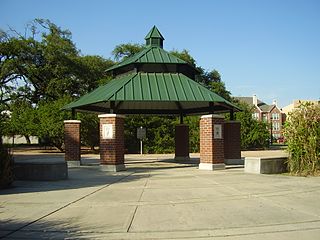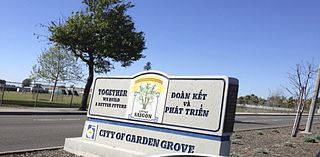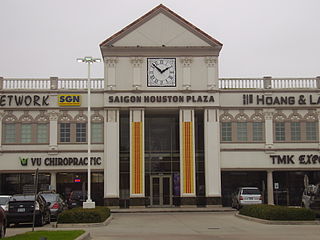
Chinatown is the catch-all name for an ethnic enclave of Chinese people located outside Greater China, most often in an urban setting. Areas known as "Chinatown" exist throughout the world, including Europe, Asia, Africa, Oceania, and the Americas.

Ho Chi Minh City, commonly known as Saigon, is the most populous city in Vietnam, with a population of around 10 million in 2023. The city's geography is defined by rivers and canals, of which the eponymously-named Saigon River is the largest. As a municipality, Ho Chi Minh City consists of 16 urban districts, five rural districts, and one municipal city (sub-city). As the largest financial centre in Vietnam, Ho Chi Minh City has the highest gross regional domestic product out of all Vietnam provinces and municipalities, contributing around a quarter of the country's total GDP. Ho Chi Minh City's metropolitan area is ASEAN's 6th largest economy, also the biggest outside an ASEAN country capital.

The Chinatown–International District of Seattle, Washington is the center of the city's Asian American community. Within the district are the three neighborhoods known as Chinatown, Japantown and Little Saigon, named for the concentration of businesses owned by people of Chinese, Japanese and Vietnamese descent, respectively. The geographic area also once included Manilatown.

Vietnamese Americans are Americans of Vietnamese ancestry. They comprise approximately half of all overseas Vietnamese and are the fourth-largest Asian American ethnic group following Chinese Americans, Indian Americans, and Filipino Americans. There are approximately 2.3 million people of Vietnamese descent residing in the U.S. as of 2023.

Little Saigon is a name given to ethnic enclaves of expatriate Vietnamese mainly in English-speaking countries. Alternate names include Little Vietnam and Little Hanoi, depending on the enclave's political history. To avoid political undertones due to the renaming of Saigon to Ho Chi Minh City, it is occasionally called by the neutral name Vietnamtown. Saigon is the former name of the capital of the former South Vietnam, where a large number of first-generation Vietnamese immigrants emigrating to the United States originate from, whereas Hanoi is the current capital of Vietnam.
Oklahoma City's Asia District, also known as the Asian District, is the center of Asian culture and International cuisine and commerce in the state of Oklahoma. It contains the largest population of Asian Americans and descendants from Asia in the state.

Chinatowns in Asia are widespread with large concentrations of overseas Chinese in East Asia and Southeast Asia, and ethnic Chinese whose ancestors came from southern China — particularly the provinces of Guangdong, Fujian, and Hainan — and settled in countries such as Brunei, Cambodia, East Timor, Indonesia, India, Laos, Malaysia, Myanmar, the Philippines, Singapore, Sri Lanka, Thailand, Vietnam, Japan and Korea centuries ago — starting as early as the Tang dynasty, but mostly notably in the 17th–19th centuries, and well into the 20th century. Today the Chinese diaspora in Asia is primarily concentrated in Southeast Asia; however, the legacy of the once widespread overseas Chinese communities in Asia is evident in the many Chinatowns found across East, South and Southeast Asia.

Urban Chinatowns exist in several major European cities. There is a Chinatown in London, England, as well as major Chinatowns in Manchester, Birmingham, Newcastle and Liverpool. In Paris there are two Chinatowns: one where many Vietnamese – specifically ethnic Chinese refugees from Vietnam – have settled in the Quartier chinois in the 13th arrondissement of Paris which is Europe's largest Chinatown, and the other in Belleville in the northeast of Paris. Berlin, Germany has two Chinatowns, one in the East and one in the West. Antwerp, Belgium also has an upstart Chinese community.

Midtown is a central neighborhood of Houston, located west-southwest of Downtown. Separated from Downtown by an elevated section of Interstate 45, Midtown is characterized by a continuation of Downtown's square grid street plan, anchored by Main Street and the METRORail Red Line. Midtown is bordered by Neartown (Montrose) to the west, the Museum District to the south, and Interstate 69 to the east. Midtown's 325 blocks cover 1.24 square miles (3.2 km2) and contained an estimated population of nearly 8,600 in 2015.

Chinatowns are enclaves of Chinese people outside of China. The first Chinatown in the United States was San Francisco's Chinatown in 1848, and many other Chinatowns were established in the 19th century by the Chinese diaspora on the West Coast. By 1875, Chinatowns had emerged in eastern cities such as New York City, Boston, Pittsburgh, and Philadelphia. The Chinese Exclusion Act of 1882 barred Chinese immigration to the United States, but the Magnuson Act of 1943 repealed it, and the population of Chinatowns began to rise again.

This article discusses the history of Vietnamese Americans and Vietnamese immigrants in Houston, Texas, and its environs. Vietnamese immigration has occurred in Greater Houston, including Fort Bend County and Harris County, since 1975, after the Vietnam War ended and refugees began coming to the United States.

Little Cambodia or Cambodia Town is a term that refers to an ethnic enclave of people from the country of Cambodia.

One of the largest Vietnamese neighborhoods in the United States is Philadelphia's Little Saigon, located in Passyunk Square, a neighborhood in South Philadelphia. This heart of the Philadelphia metropolitan area's rapidly growing Vietnamese community is centered on the intersection of S. Eighth Street and Washington Avenue in South Philadelphia, with "one of the largest Vietnamese populations on the east coast," and is a district where "... neon signs lure shoppers into grocery stores, restaurants, and karaoke bars set back from the street in low-rise concrete strip malls. Shoppers pushing carts laden with rice noodles, bean cakes and imported spices and sauces pack suburban-style parking lots behind the complexes." The author further states that the Vietnamese are now the largest ethnic community in the Washington Avenue/Passyunk Square section of the city and that the entire Vietnamese population of Philadelphia is larger than that of New York City.

The Little Saigon district straddling the cities of Garden Grove and Westminster in Orange County, California is the largest Little Saigon in the United States. Saigon is the former name of the capital of the former South Vietnam, where a large number of first-generation Vietnamese immigrants originate.
Little Saigon is the Vietnamese ethnic enclave in the Clarendon neighborhood of Arlington, Virginia, which served the large refugee population that immigrated after the Fall of Saigon on April 30, 1975. One of many Little Saigons in the U.S., this neighborhood near Washington, D.C., became a hub of Vietnamese commerce and social activity, and reached its peak during the late 1970s to the early 1980s. The opening of the Clarendon station on the Washington Metro's Orange Line led to new development and higher rents; many businesses closed or moved, notably to the nearby Eden Center.

The Historic Chinatown Gate is a modern Paifang archway in the Chinatown-International District neighborhood of Seattle, Washington.

Little Saigon, also popularly known as Vietnamtown or simply Viet-Town, is a neighborhood in Houston, Texas centered on Bellaire Boulevard west of Chinatown. It is one of the largest Vietnamese enclaves in the United States.

Little Saigon is a neighborhood of San Jose, California, located in East San Jose. It is a hub for Silicon Valley's Vietnamese community and one of the largest Little Saigons in the world, as San Jose has more Vietnamese residents than any city outside of Vietnam. Vietnamese Americans and immigrants in San Jose make up ten percent of the city’s population and about eight percent of the county and South Bay Area.

Saigon Vietnam Deli is a Vietnamese restaurant in Seattle's Chinatown–International District, in the U.S. state of Washington.

Viet-Wah is a chain of Asian / Vietnamese supermarkets in the Seattle metropolitan area, in the U.S. state of Washington. Established in 1981, the business specializes in Vietnamese, Chinese, and Thai products and such as duck and quail eggs, noodles, seafood, chicken hearts, and fish sauce.
















